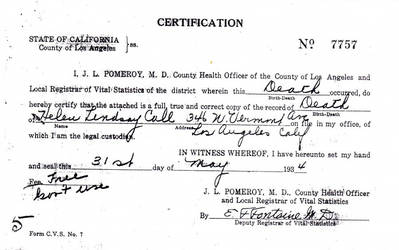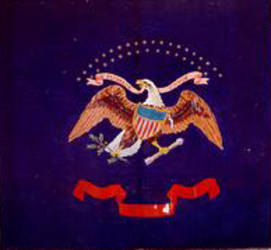Frank J. Call
Representing: Union
G.A.R Post
- John Buford Post #89 Everett, Snohomish Co. WA
Unit History
- 23rd Ohio Infantry K
- 150th Ohio Infantry K
- 5th USCT Infantry K & H
Full Unit History
23rd OHIO VOLUNTEER INFANTRY
Organized: 6/61 to 3/62 Camp Chase, Columbus, OH
Mustered Out: 7/26/65 Cumberland, MD
150th OHIO VOLUNTEER INFANTRY
Organized: 5/5/64 Cleveland, OH
Mustered Out: 8/23/64 Cleveland, OH
5th U.S. COLORED VOLUNTEER INFANTRY
Organized: 10/1/63 Camp Delaware, OH
Mustered Out: 9/20/65
Regimental History
REGIMENTAL HISTORY: (23rd)
Organized over a period of months, elements of this three year regiment left the state for western VA in July, ’61 and were almost at once in conflict with the enemy. Interestingly, two of the regiment’s initial colonels were William S. Rosecrans, later a Union general, and Rutherford B. Hays, a future U.S. president. Throughout its period of service this eastern theater regiment was assigned to western and northern Virginia including the Shenandoah Valley.
In Sept., ’62 the unit proceeded to Washington, D.C. and thence, Maryland where it took part in the battles of South Mtn. and Antietam. At South Mtn. it lost nearly 200 men, almost ¼ of whom were either killed on the field or died later of wounds. Spring, 1863 saw the 23rd moved to Charleston, WVA. Although this was a period of relative inactivity, in mid year the regiment participated in movements against Confed. Gen. Morgan’s northern raid. In this vein, it headed off Morgan’s forces at Buffington Island, Ohio and captured a number of the guerillas as they attempted to cross the river.
In May, 1864 as Union Gen U.S. Grant and the Army of the Potomac moved southward, the 23rd was in action at Cloyd’s Mtn. and New River Bridge severing the south’s food lifeline from the Shenandoah. The march to and retreat from Lynchburg was followed by the battle of Winchester.
During this Union loss the regiment lost 153 men including 10 commissioned officers. After several other battles, on Oct. 19th the unit was engaged at Cedar Creek, where the timely arrival of Union Gen. Phillip Sheridan turned defeat into victory for the blue forces and effectively ended Confederate operations within the Shenandoah Valley. A quiet winter preceded the 23rd’s final muster.
REGIMENTAL HISTORY: (150th)
In the spring of 1864 Union forces began what would prove to be the final push to quell the Rebellion. In order to place as many seasoned troops as possible in the field, veteran regiments were pulled from garrison and railroad guard duty while a number of “100 day” regiments were organized to fill the resulting vacancies. The 150th was one such regiment. It was created by uniting three existing Ohio home front units. Throughout its term of service the 150th garrisoned many of the forts that formed a defensive ring around the nation’s capital. In this capacity, in July it participated in defending Washington from an attack by rebel forces lead by Confed. Gen. Jubal A. Early. Regimental losses: 4 officers and 72 enlisted men killed by disease, accidents, etc.
REGIMENTAL HISTORY: (5th)
At the outset of America’s War of the Rebellion U.S. President Abraham Lincoln rejected the idea of abolishing slavery or tapping African-Americans for military manpower. By mid 1862, however, Lincoln had come to recognize that one way to weaken the surprisingly resilient Confederacy was to undermine slavery.
As such following promulgation of his 1/1/63 Emancipation Proclamation the Union army initiated a vigorous recruitment drive which ultimately saw the arming of 166 black regiments: 145 of infantry, 7 of cavalry, 12 of heavy artillery, 1 of light artillery, and one of engineers.
Initially, and throughout most their existence, the regiments were, for the most part, officered by white soldiers. The 5th first saw action 12/8/63 at Sandy Swamp, NC. In early ’64 it moved to VA where it was active around Richmond and Petersburg. In mid year it was present for the “mine explosion” under the fortifications of the latter city.
Returning to North Carolina, the regiment participated in the siege and capture of Ft. Fisher and in other engagements before, in March and April, 1865 marching northward through the Carolinas with Union Wm. T. Sherman’s armies.
The advance upon and occupation of Raleigh, NC preceded the surrender of Confed. Gen. A.S. Johnston’s army in late April. Duty in North Carolina was followed by final muster. Losses: 4 officers and 72 enlisted men killed/mortally wounded. 2 officers and 166 enlisted men died from disease. Total: 429.
Soldier History
SOLDIER: (23rd )
Residence: Inf. Not Avail. Age: 17.3 yrs
Discharged: 11/3/62 Gallipolis, OH
Highest Rank: Pvt.
SOLDIER: (150th)
Residence: Inf. Not Avail. Age: 20.2 yrs.
Enlisted/Enrolled: 6/11/61 Elyria, OH Rank: Pvt
Mustered Out: 8/23/64 Cleveland, OH
Mustered Out: 8/23/64 Cleveland
SOLDIER: (5th)
Residence: Inf. Not Avail. Age: 20.7 yrs.
Enlisted/Enrolled: 9/5/64 Rank: 2nd Lieut.
Discharged: 9/20/65
Highest Rank: 1st Lieut
Family History
PERSONAL/FAMILY HISTORY:
According to his obituary, Frank James Call was born on February, 15, 1844 in Eden, NY. Although other sources mention 1845 and 1847, for our purposes 1844 is being accepted as factual. All that is known about his birth family is that he had at least one brother, William, and one sister, Helen. Nothing is known about his childhood or formative years other than, after moving to Ohio with his parents, he received a “common school” (public school) education.
When the War of The Rebellion broke out the 5’7” teenaged farmer joined the U.S. Army. Of interest in this enlistment was Private Call’s first and middle names being noted as James Frank rather then Frank James. Available records do not address the change. Whatever his name, the enlistment experience proved to be a medical disaster as it seems the slightest exposure to the elements of nature prostrated him with severe, chronic diarrhea.
In the fall of 1862 he was granted a disability discharge. A year and one half later, apparently hale and healthy, young Mr. Call again enlisted in the U.S. Army. This relatively short service term apparently proved satisfactory as evidenced by the fact that almost immediately following his discharge Mr. Call reenlisted.
This time he was commissioned as a 2nd Lieutenant in Co. “C” of the 5th U.S. Colored infantry. With the 5th Lieutenant Call’s abilities in the fields around Richmond quickly brought him to the attention of his superiors who recommended him for promotion. Promoted to 1st Lieutenant in January, 1865 (The promotion was not official until March/April.) Lieutenant Call was sent to the 109th U.S. colored infantry, but upon presenting himself and finding there were no lieutenant vacancies, requested and received a transfer back to the 5th. In April he commanded Co. “K” of that regiment. He spent the remainder of his enlistment with Co. “H.”
Wartime service behind him, citizen Call returned to Ohio where he attended college. He also taught school for one/two terms. By the early 1870’s Frank had removed to Chicago, IL. There, on 9/30/73 he married Helen “Nellie” Elizabeth Lindsay (b. 11/18/55 IL). The union produced at least 4 children: Harry L. (b. 1875 IL), Katherine “Kittie” (b. 1877 MN), Howard (b. 1879 ND), Grant (b. ND. Apparently died at an early age.) and Frank Roscoe (1/22/88).
Mr. Call’s obituary noted that while in North Dakota he “accumulated a fortune, but reverses came and swept it all away.” As a result, in 1890 it appears he left his wife and children and traveled further “west to try and recover some of this world’s goods.” Circa 1892 Call settled in Everett, WA. What drew him to the Puget Sound area of the Pacific Northwest is not documented, but once there he “endeared himself to the hearts of all who came into contact with him.”
According to his obituary, “for a time he was local agent for the Canadian Pacific railroad. He also held a number of responsible public positions and was well known not only in Everett, but throughout the western part of the state. He did considerable newspaper and magazine writings.” (In the 1900 U.S. Census he listed his occupation as “correspondent.”)
Frank J. Call died 9/30/04 at the age of 60.7 years. Cause of death was Bright’s (kidney) disease. At passing he was a resident of the Hotel Colby in Everett. Nellie, who had never divorced him, reportedly visited just prior to his death, but had returned to North Dakota and son Roscoe by the time of the death and funeral.
As for his funeral, it was originally to be held at the hotel, but because of the number of people in attendance was “marched” to the nearby 1st Presbyterian Church. The Everett Herald newspaper described the occasion this way, “The funeral procession was an unusually long one. It included the G.A.R., the Ladies of the G.A.R. and Company K. The floral offerings were many and beautiful…. At the grave Captain Call was given the last rites of a soldier. Three volleys were fired over the grave by company and the bugler sounded “taps.” Of particular note are newspaper articles consistently referring to the old soldier as “Captain Call.”
In pension papers filed by Nellie on 3/11/05 she noted that her late husband had been discharged from the military for the final time on 10/6/65 with the rank of captain. However, as previously noted, Mr. Call’s final discharge date was in September, 1865 and at the time his rank was 1st Lieutenant. As such, it appears likely the “Captain” designation was strictly an honorarium.
In 1904 Frank applied for a U.S. government pension based on his Civil War soldiering. He apparently died before the request could be acted upon. Although Nellie requested a widow’s pension in 1905, it is not known if such was granted. Nellie never remarried. She died 4/27/34 in Los Angeles, CA. Son Harry then had her remains transported to Sacramento.
Cemetery
Buried at Evergreen Cemetery in Everett
Row: 5
Site: GAR section 8
Adopt-a-Vet Sponsor
Candy Crawford
Wenatchee, WA








